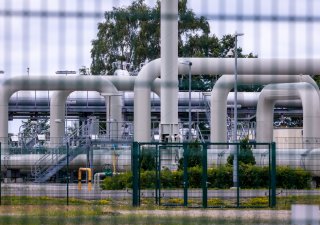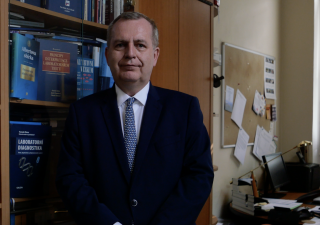Copper prices are falling sharply on global markets and the key production metal has had its worst week this year. The last time the price of copper fell this significantly was in 2008. Coincidence? No, according to Bloomberg, the current moves in copper represent the strongest confirmation yet of an impending recession and a general slowdown in demand.
Signals of a fundamental slowdown in the world economy are beginning to multiply in the markets. One of the key factors may be the price of copper, which is “used in almost everything from cars to iPhones,” writes the Bloomberg agency. From record levels, copper has fallen by 33 percent, and this year alone the production metal has lost 26 percent of its value. According to Bloomberg, it is headed for the worst annual decline since 2008, when the global financial crisis started.
“Demand for copper varies from region to region. However, no one in the world is betting on the growth of this commodity at the moment,” commented Michael Widmer of Bank of America on the current situation.
The reason is the cooling of demand, which is supposed to be brought about by the approaching crisis. According to manufacturers, recession is inevitable due to the mix of a whole range of negative influences on the global market. “China’s lockdowns and significant economic slowdown, rising interest rates, recession expectations and ongoing supply chain issues are all still there. The dominoes are falling,” Phil Streible, chief strategist of the investment company Blue Line Futures, described the market situation. At the same time, he confirmed that it is currently impossible to estimate where copper will sink.
Trader’s week: The global economy slows down and Europe redistributes
July certainly does not resemble any cucumber season yet. The markets, although not in a panic sell-off, mainly fell again, even in view of the large supply of relatively negative macroeconomic data.
Drop below $7000
At the moment, the price on the London Metal Exchange hovers around $7,000 per ton, and its volatility is influenced not only by expectations of a recession, but also by high inflows of speculative money. Despite this, major institutions are gradually reducing the target amounts. For example Goldman Sachs cut its target price for copper this week by 22 percent to $6,700 per ton.
The falling price of copper can then spin an unpleasant spiral, as companies mining this productive metal, such as Freeport-McMoRan, may soon get into trouble. According to Bloomberg, rising costs have a significant impact on the company’s economy, and while a year ago the market price of $6,270 was enough to produce one ton of copper, currently copper would have to cost $7,500 in order for miners to break even. Because of this, Freeport-McMoRan shares have lost 40 percent since the beginning of the year.

It makes everything more expensive, but there are exceptions. A kilo of scrap iron will buy you back for a fraction of what it was in the spring
Prices of virtually everything across the economy are rising rapidly. Nevertheless, there are exceptions. For example, the purchase prices of collected raw materials are falling. And dramatically so. So people should hurry up with the collection. In a while, he may not get anything at all, points out the chief economist of Trinity Bank Lukáš Kovanda. According to him, the collapse of purchase prices in raw materials is one of the litmus tests indicating that an economic crisis is approaching.
A threatened transition
Problems in the copper market can then bring a major crack in the green revolution that the world is planning for 2050. It is an important commodity for electric cars, wind and solar power plants, as well as for the infrastructure that ensures the transport and storage of renewable energy.
By 2035, demand for copper is expected to nearly double to 50 million tons. By 2050, it will reach more than 53 million tons. That’s more than all the copper consumed in the world between 1900 and 2021, according to S&P Global.

The world’s copper shortage threatens climate goals. And demand will skyrocket
Demand for copper is surging, but supply is unable to keep pace with demand, potentially derailing the energy transition and jeopardizing the goal of net zero emissions. Copper is important for electric cars, wind and solar power plants, as well as the infrastructure that transports and stores renewable energy. By 2035, the demand for copper is expected to almost double. Unless significant new supplies are available, climate targets will remain unattainable. This follows from a study by S&P Global, which was highlighted by the CNBC server.
Unless significant new supplies are available, climate targets will remain unattainable. This follows from a study by S&P Global, which was highlighted by the CNBC server.
“The energy transition will be much more dependent on copper than our current energy system,” S&P Global Vice Chairman Daniel Yergin told CNBC. “Copper is the metal of electrification and is largely what the transition to new energy is all about,” he added.

Dalibor Martínek: Russia will destroy us economically, but in Europe we continue to solve the climate senselessly
The shutdown of the Nord Stream 1 gas pipeline, which carries Russian gas to Germany, has begun. And that in turn flows from Germany to the Czech Republic. The reservoirs will not be filled for the winter now.

video
Tomáš Zima: I have the ability to bring people together, connect them. And I’ve never done curves
In the second part of the Kafe with the President series, we present an interview with the former rector of Charles University Tomáš Zima. At the age of fifty-six, he has already spent eight years at the head of Charles University, the largest and most important domestic university. He is crowned with titles such as Prof, MUDr, MBA, DrSc. and several others. It is impossible to count how many organizations he holds important positions in.
–

